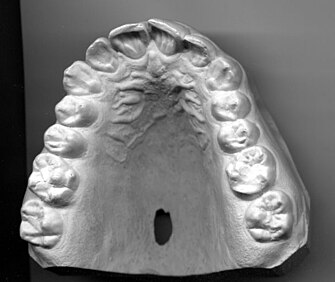
Back مجموع سني Arabic Diş formulu Azerbaijani Denticija BS Dentició Catalan Chrup Czech Gebiss German Dentición Spanish چینش دندان Persian Denture French दंतुरण Hindi

Dentition pertains to the development of teeth and their arrangement in the mouth. In particular, it is the characteristic arrangement, kind, and number of teeth in a given species at a given age.[1] That is, the number, type, and morpho-physiology (that is, the relationship between the shape and form of the tooth in question and its inferred function) of the teeth of an animal.[2]
Animals whose teeth are all of the same type, such as most non-mammalian vertebrates, are said to have homodont dentition, whereas those whose teeth differ morphologically are said to have heterodont dentition. The dentition of animals with two successions of teeth (deciduous, permanent) is referred to as diphyodont, while the dentition of animals with only one set of teeth throughout life is monophyodont. The dentition of animals in which the teeth are continuously discarded and replaced throughout life is termed polyphyodont.[2] The dentition of animals in which the teeth are set in sockets in the jawbones is termed thecodont.